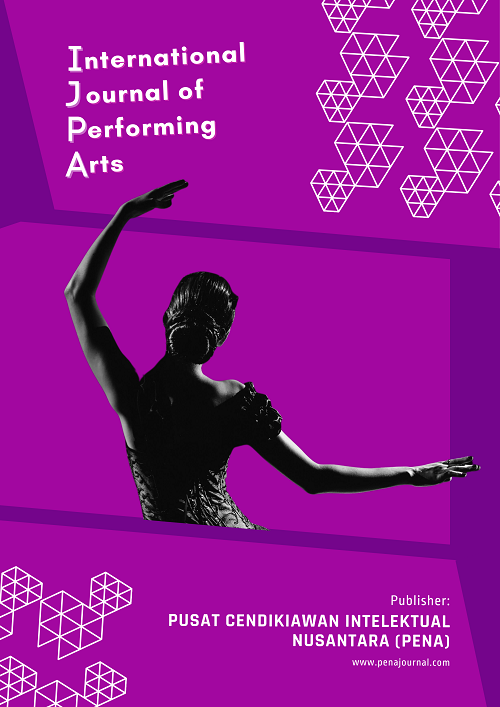AUGMENTED REALITY DANCE LEARNING MEDIA: LABAN NOTATION MOVEMENT LITERACY FOR JUNIOR HIGH SCHOOL STUDENTS
AUGMENTED REALITY DANCE LEARNING MEDIA: LABAN NOTATION MOVEMENT LITERACY FOR JUNIOR HIGH SCHOOL STUDENTS
DOI:
https://doi.org/10.56107/ijpa.v4i1.247Keywords:
media pembelajaran tari, augmented reality, literasi gerak, notasi laban, deep learning, siswa SMPAbstract
This study aims to introduce dance learning media using Augmented Reality with Movement Literacy
material based on Laban Notation symbols for junior high school students. The background of the
study is based on the low interest of students in learning dance and difficulties in understanding the
elements of space, time, and energy due to the limitations of conventional media that are not in
accordance with the characteristics of the digital generation. The method used is research and
development (R&D) with initial stages including needs analysis, product design, product
development, implementation through limited trials, and product evaluation. The product developed
is an Augmented Reality (AR) application that presents movement literacy based on Laban Notation
in an interactive 3D form, so that students can learn movement visually, kinesthetically, and
reflectively. Initial results based on needs analysis and the designed product show that the
application is considered interesting, easy to use, and helps understand basic dance movements, and
is in accordance with the characteristics of students in the digital era. Teachers gave positive
responses to the potential of this media as a supporter of deep learning that is conscious, meaningful,
and enjoyable. Thus, it is hoped that the AR-Motion Literacy application can be an innovative
alternative in dance learning, especi
References
Arsyad, A. (2019). Media Pembelajaran Edisi Revisi. Rajawali Pers.
Branch, R. M. (2009). Instructional design: The ADDIE approach. Springer.
Hutchinson, A. (1970). Labanotation: The system of analyzing and recording movement. Theatre
Arts Books
Mayer, n. d. (n.d.). ognitive theory of multimedia learning. The Cambridge Handbook of
Multimedia Learning.
Paivio, A. (1986). Mental representations: A dual coding approach. Oxford University Press
Studd, C., & Cox, L. (2013). EveryBody is a Body: Laban and Bartenieff movement analysis in
therapeutic practice. Singing Dragon.
sugiyono. (2019). Metode Penelitian Pendidikan: Pendekatan Kuantitatif, Kualitatif, dan R&D.
Alfabeta
Wang, F., & Burton, J. (2012). The use of augmented reality in teaching and learning. International
Journal of Computer-Assisted Learning, 28(4), 307–318.
Widoyoko, E. P. (2018). Evaluasi Program Pembelajaran. Pustaka Pelajar
Journal reference
Azuma, R. T., Baillot, Y., Behringer, R., Feiner, S., Julier, S., & MacIntyre, B. (2001). A Survey of
Augmented Reality. Presence: Teleoperators and Virtual Environments, 10(1), 1–35.
Bucek, L. (1998). Dancing in the mists: Developing movement literacy. Dancing in the Mists:
Developing Movement Literacy. Journal of Physical Education, Recreation & Dance, 69(1),
–38.
Volume 4 No.2 (2025)
Augmented Reality Dance Learning Media: Laban Notation Movement Literacy for Junior High
School Students
Siti Fatmasari, Dinny Devi Triana, Jeong OK Jeon
INTERNATIONAL JOURNAL OF PERFORMING ARTS
https://penajournal.com/index.php/IJPA/
Dwiyana Habsary, H., Setyobudhi, R., & Permadi, A. (2024). Analisis kesulitan siswa SMP dalam
memahami simbol arah dan level gerak tari tradisional. Jurnal Pendidikan Seni Tari, 10(2), 1–
Fredricks, J. A., Blumenfeld, P. C., & Paris, A. H. (2004). School engagement: Potential of the
concept, state of the evidence. Review of Educational Research, 74(1), 59–109.
Ismiati, A., Fujiawati, F. S., & Permanasari, A. T. (2021). Perancangan aplikasi magic card
augmented reality pada gerak dasar tari Sunda. JPKS (Jurnal Pendidikan Dan Kajian Seni),
(2), 127–142.
Kusumawati, Y., & Arifin, M. (2023). Pengembangan media pembelajaran tari berbasis aplikasi
augmented reality pada materi gerak dasar. Jurnal Pendidikan Seni, 14(1), 1-15.
Lee, Y. (2022). The impact of digital dance literacy education on students' creative performance.
Journal of Dance Education, 22(4), 187-195.
Prensky, M. (2001). Digital natives, digital immigrants. On the Horizon. 9(5), 1–6.
Purba, R. W., Setyaningsih, D., & Sari, I. D. (2023). Augmented reality development for teaching
traditional dance in the digital era. . . International Journal of Interactive Mobile
Technologies, 17(4), 168–185.
Triana, D. D., Yudha, R. P., & Adhi, B. P. (n.d.). Movement Literation Educational Game Based
on Dance Notation to Diagnostic Kinesthetic Intelligence of Junior High School Students.
Journal of Scientific Research, Education, and Technology (JSRET), X(Y), 94–107.
Utami, W. W., Hidayati, N., & Santoso, Y. B. (n.d.). Efektivitas aplikasi augmented reality dalam
meningkatkan pemahaman gerak tari pada siswa SMP. Jurnal Pendidikan Teknologi
Informasi, 6(2), 110–125.
Valdez, A. A., & Zuk, J. (2023). Augmented reality in dance education: A systematic review.
Journal of Dance and Somatic Practices, 15(1), 65-80.
Wang, F., & Burton, J. (2012). The use of augmented reality in teaching and learning. International
Journal of Computer-Assisted Learning, 28(4), 307-318.
Yusuf, M., Hidayat, A., & Sari, D. P. (2020). Pengembangan media pembelajaran augmented
reality untuk pengenalan ragam gerak tari tradisional. Jurnal Pendidikan Seni, 11(2), 150-165.
Published paper in conference proceedings
Triana, D. D., Kusumawardani, D., Rahayu, W., Widiastuti, & Yudha, R. P. (2020)
“Labanotation-Based Motion Literation Teaching Materials To Diagnow Intelligent Kinestetic
Students In Junior High Schools Through E-Learning”





















